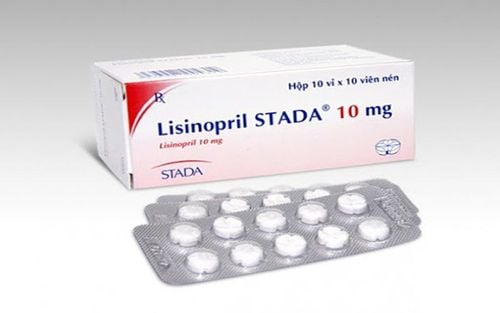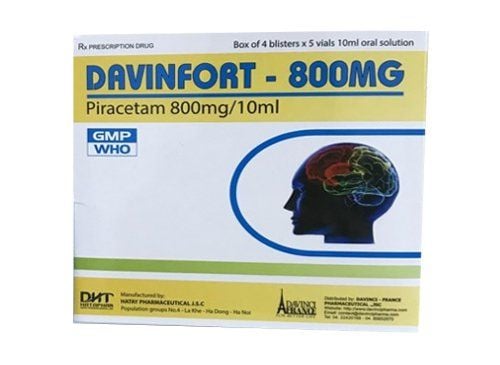This is an automatically translated article.
Agihistine 8 mg drug with the main ingredient is Betahistine dihydrochloride, manufactured by Agimexpharm Pharmaceutical Joint Stock Company, Vietnam. Agihistine is prescribed by doctors to treat dizziness in vestibular disorders.
1. What is Agihistine 8?
Agihistine belongs to the group of psychotropic drugs, with the main active ingredient being betahistine dihydrochloride.Dosage form: hard capsule Packing: blister of 20 tablets, box of 5 blisters. Depending on the content of betahistine dihydrochloride in each capsule, there are names called Agihistine 8 mg (containing 8mg betahistine dihydrochloride) or Agihistine 24.
So what is Agihistine 16? Similar to the above, in the composition of Agihistine 16 contains 16mg betahistine dihydrochloride. Pharmacodynamics: betahistine increases the blood flow in the inner ear by dilating the precapillary sphincter. In addition, it also has the effect of enhancing cerebral circulation, increasing blood circulation through the internal carotid artery, as well as the vertebral artery. Pharmacokinetics: betahistine is rapidly and completely absorbed into the blood and is metabolized to 2-pyridyl acetate. Betahistine is eliminated mainly in the urine, with a half-life of 3.5 hours. The drug is completely eliminated within 1 day after oral administration. Effects: The mechanism of action of betahistine in treatment has not been fully studied. However, in vitro studies have shown that betahistine facilitates histamine transmission by acting on H1 receptors and inhibiting H3 receptors.
2. Uses of Agihistine
Agihistine 8 mg is usually indicated in the following cases:
Dizziness in vestibular disorders Patients with Ménière's syndrome (a hearing disorder characterized by 3 symptoms of tinnitus, hearing loss and dizziness) face with nausea and vomiting). Contraindications: Absolutely do not use Agihistine in the following patients:
Allergic to any ingredient in Agihistine Stomach and duodenal ulcers Patients with adrenal myeloma People under 18 years of age
3. Dosage and how to use Agihistine
Agihistine is a prescription drug, you must absolutely follow the instructions of your doctor, do not arbitrarily stop taking, change the dose or give this medicine to others when they have the same symptoms as you, because Each person's condition is different, drugs can have adverse effects on their health.
Dosage: start with 1-2 tablets / time, 3 times a day. Then use a maintenance dose of 24-48mg/day. The average duration of treatment is 2-3 months.
This dose is for reference only, depending on age and medical condition, the doctor will change the dosage to bring high efficiency and limit harmful effects to health.
How to use: Patients need to take the drug with water, swallow the whole tablet, do not chew or crush. Should be taken with meals.
What to do when you miss a dose or overdose:
When you miss a dose: Take another dose as soon as you remember it. However, if it is almost time for your next dose, skip it. Absolutely do not take a double dose the next time to make up for the dose. In case of overdose: It is important to always stick to the dose prescribed by your doctor. However, a few cases of overdose have been reported. Symptoms of overdose include: nausea and vomiting, indigestion, convulsions. Currently, there is no specific antidote, what needs to be done is gastric lavage and symptomatic treatment. In addition, family members need to bring all medications that the patient is using (including vitamins and minerals, herbs, ...) for timely diagnosis.
4. Undesirable effects of Agihistine
During treatment with Agihistine, you may experience some unwanted effects. Don't be alarmed or alarmed, as any medication has side effects beyond the therapeutic effect. However, if these symptoms persist or require an emergency, contact your doctor immediately for diagnosis and treatment. Adverse effects of Agihistine include:
Rare: stomach pain, indigestion, nausea and vomiting Very rare: headache, drowsiness, rash, pruritus.
5. Some notes when using Agihistine
Care should be taken when using Agihistine in the following subjects: patients with peptic ulcer disease or a history of previous gastric and duodenal ulcer, bronchial asthma, pheochromocytoma, galactose intolerance, people with galactose intolerance. elderly (need dose adjustment and close monitoring), children (safety has not been determined when using the drug in this subject).
Notes for pregnant or lactating women: There are currently no adequate studies on the toxicity of the drug on this subject. Therefore, it is necessary to weigh the benefits of treatment with Agihistine and the possible toxicity when deciding to use the drug.
For people driving or operating machines: there is no evidence of the effect of the drug on this subject.
6. Store medicines properly
Carefully read the instructions for use of the medicine in the box and store it according to the instructions: keep the medicine in a dry place, away from light, out of reach of children and pets. The drug Agihistine 8 mg has a shelf life of 36 months, only use when the expiry date and label remain. When there are signs of deterioration or deterioration, do not use it anymore.
Agihistine 8 mg drug with the main ingredient is Betahistine dihydrochloride, manufactured by Agimexpharm Pharmaceutical Joint Stock Company, Vietnam. Agihistine is prescribed by doctors to treat dizziness in vestibular disorders. To ensure effective treatment and avoid unwanted side effects, patients need to take the drug exactly as directed by a doctor or pharmacist.
Follow Vinmec International General Hospital website to get more health, nutrition and beauty information to protect the health of yourself and your loved ones in your family.
Please dial HOTLINE for more information or register for an appointment HERE. Download MyVinmec app to make appointments faster and to manage your bookings easily.













